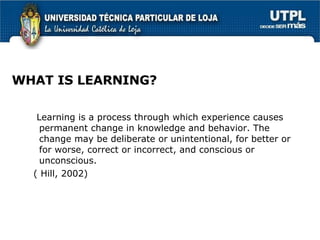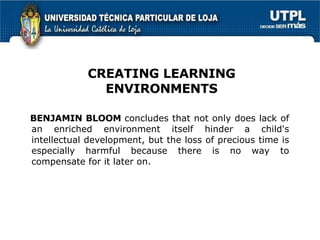Development Psychology and Learning (II Bimestre)
- 1. ESCUELA : PONENTE : BIMESTRE : DEVELOPMENTAL PSICHOLOGY AND LEARNING CICLO : INGLÉS II BIMESTRE Dra. María Arias ABRIL – AGOSTO 2007
- 2. FUNDAMENTALS OF GROWTH AND DEVELOPMENT: THE NATURE-NURTURE CONTROVERSY Of all the great debate in the history of Psychology, and there have been many, the one that has generated the most heat and caused the greatest division in the field is the controversy over the relative influences of nature and nurture The hereditarians, who favored nature, stridently claimed that all psychological traits were transmitted directly through the genes from generation to generation. The environmentalists held that all people were born genetically equal and that later differences among them were only a result of different environmental opportunities. For hereditarians, environment was of little consequence. For environmentalists, g enetic endowment was romantic myth, used to keep kings on their thrones, but of no use to science.
- 3. WHAT IS LEARNING? Learning is a process through which experience causes permanent change in knowledge and behavior. The change may be deliberate or unintentional, for better or for worse, correct or incorrect, and conscious or unconscious. ( Hill, 2002)
- 4. BEHAVIORAL VIEWS OF LEARNING Learning occurs when experience causes a relatively permanent change in an individual's knowledge or behavior but it is not always intentional. We all learn to find a new style of dress attractive when the old styles ( the styles once loved) go out of fashion.
- 5. CHANGES IN LEARNING Most psychologists agree that changes resulting from learning are in the individual's knowledge or behavior but some tend to emphasize the change in knowledge, others the change in behavior.
- 6. DIFFERENCES IN LEARNING COGNITIVE PSYCHOLOGISTS: Learning is an internal mental activity that cannot be observed directly. BEHAVIORAL PSYCHOLOGISTS: The outcome of learning is change in behavior, and it emphasizes the effects of external events on the individual.
- 7. COGNITIVE VIEWS OF LEARNING Knowledge is learned, and change in knowledge makes changes in behavior possible. The cognitive view sees learning as: “ Transforming significant understanding we already have, rather than simple accquisitions written on blank slates”.
- 8. Thorndike`s early work involved cats, dogs, chicks and monkeys that he placed in puzzle boxes. To escape from the box and reach food outside, the cats had to pull out a bolt or perform some other task. The cats eventually made the correct movement to escape, usually by accident. After repeating the process several times, the cats learned to make the correct response almost immediately. He decided, on the basis of these experiments, that one important law of learning was the LAW OF EFFECT. Thorndike established the basis for OPERANT CONDITIONING. OPERANT CONDITIONING THE WORK OF THORNDIKE ( 1874-1949)
- 9. The Law of Effect states that the consequence, or effect of a response determines whether the tendency to respond is the same way in the future will be strengthened or weakened. Responses closely followed by satisfying consequences are more likely to be repeated. Thorndike ( 1898 ) insisted that it was “ unnecessary to involve reasoning” to explain how the learning took place.. THE LAW OF EFFECT
- 10. MAJOR CONTRIBUTION: Like Watson, Skinner believed that the causes of behavior are in the environment and do not result from inner mental events such as thoughts, feelings, or perceptions. Skinner claimed that these, inner mental events are themselves behaviors, and like any other behaviors, are shaped and determined by environmental forces. B. F. SKINNER (1904-1990)
- 11. A VOICE FOR HEREDITARIANS HENRY E. GODDARD AND THE “ BAD SEED”
- 12. KALLIKAK FAMILY GODDARD: ”THE DIFFERENCE WAS HEREDIDITY” MARTIN KALLIKAK GOOD KALLIKAKS 7 CHILDREN 496 Doctors, lawyers, business leaders, college presidents BAD KALLIKAS ONE SON “ OLD HORROR” BAD KALLIKAKS 480
- 13. A VOICE FOR THE ENVIRONMENTALISTS: JOHN WATSON AND “ GIVE ME THE BABY” A Human baby is nothing more than a lump of clay that can be molded and fashioned into any shape by the master artisan, the environment. John Watson is considered the father of behaviorism. Watson`s belief was that people are made not born, that a baby can be shaped into any adult form-trapeze artist, musician, master criminal through the judicious use of conditioning techniques.
- 14. THE IMPORTANCE OF KNOWLEDGE IN LEARNING Knowledge is the outcome of learning. It guides new learning. Knowledge determines to a great extent what we will pay attention to, perceive, learn, remember, and forget ( Docky, Segers,Buehl, 1999; Greeno, Collins, & Resnick, 1996 ) Knowledge is more than the end product of previous learning.
- 15. Cognition The mental processess that are involved in acquiring, storing, retrieving, and using information and that include sensation, perception, imagery, concept formation, reasoning, decision making, problem solving, and language.
- 16. Perception The process of detecting a stimulus and assigning meaning to it. This meaning is constructed based on both physical representations from the world and our existing knowledge. “ Interpretación of sensory information”
- 17. METACOGNITION “ KNOWLEDGE ABOUT OUR OWN THINKING PROCESS”
- 18. INDIVIDUAL DIFFERENCES IN METACOGNITION. Some differences in metacognitive abilities are the result of development. As children grow older they are more able to exercise executive control over strategies. Metacognitive abilities begin to develop around ages 5 to 7 and improve through school.
- 19. General and Specific knowledge General knowledge Declarative, Procedural, and Conditional knowledge Specific understanding The Importance of Knowledge General cognitive abilities Memory
- 20. COMPLEX COGNITIVE PROCESS What is insight and how does it affect learning? Insight is the sudden realization of the relationship of the elements in a problem situation that makes the solution apparent; this solution is easily learned and transferred to new problems.
- 21. IDEAL Identify problems and opportunities Define goals and represent the problem Explore possible strategies Anticipate outcomes and Act Look back and Learn PROBLEM SOLVING Some psychologists believe that effective problem-solving strategies are specific to the problem area. The other side of the debate claims that there are some general problem-solving strategies that can be useful in many areas
- 22. Factors that interfere Factors that hinder problem solving include functional fixedness or rigidity DEFINING GOALS AND REPRESENTING THE PROBLEM To represent the problem and set a goal, you have to focus attention on relevant information, understand the words of the problem, and activate the right schema to understand the whole problem.
- 23. Problem Solving: creating new solutions for problems. HOW DO MISCONCEPTIONS INTERFERE WITH LEARNING? If the students` intuitive model includes misconceptions and inaccuracies, then the students are likely to develop inadequate or misleading representations of a problem. In order to learn new information and solve problems, students must sometimes “ unlearn” common sense ideas.
- 24. Mostly Americans Learning theorists were bound to be strong influence on Educational Psychology. The behaviorists – Watson, Thorndike, Guthrie, Hull, and Skinner- spread a kind of mechanical-person gospel. They spent little time studying the organism´s growth and development. The emphasis was on how the organism was learned, regardless of its inherited potential , regardless of its stage of physical or psychological development , and often regardless of its species . THE LEARNING THEORISTS SOCIAL COGNITIVE AND CONSTRUCTIVIST VIEWS OF LEARNING
- 25. In brief, they saw learning as a result of associations formed between stimuli and actions or impulses to act. Learning was seen largely as a result of conditioning, similar to Pavlov's dog learning to salivate at the sound of a certain tone. From his command post at Columbia Teachers College, E. L. Thorndike issued basic laws of learning that dominated the field of educational psychology, not to mention classroom practices, for more than 50 years. THE LEARNING THEORISTS SOCIAL COGNITIVE AND CONSTRUCTIVIST VIEWS OF LEARNING
- 26. Why was the environmental position so attractive in the United States? 1. American psychology was dominated by liberals, and almost all of them adopted an environmental stance. To their way of thinking, heredity doomed humans to a tooth-and-claw world, a racist society in which social change was impossible. The nature-nurture argument was rephrased in more “democratic” language as “instinct versus language”. An ideology, a cherished tradition, was getting between the psychologists and their data. THE LEARNING THEORISTS SOCIAL COGNITIVE AND CONSTRUCTIVIST VIEWS OF LEARNING
- 27. 2. The feeling was that heredity was fixed at conception and that there was no point in studying something that coludn´t be changed. Environmental influences, however, could be manipulated, and heredity became unimportant simply because of its inaccessibility. 3. Genetics was a relatively new field, and very few psychologists were familiar with the information developing in the field. THE LEARNING THEORISTS SOCIAL COGNITIVE AND CONSTRUCTIVIST VIEWS OF LEARNING
- 28. The special field of behavior, genetics had not yet evolved. Indeed, the relationship between genetic inputs and overt behavior remained largely unresearched until the 1970s. Instinct theory attemped to explain behavior by describing it in other terms: Why do people fight? Because they have an aggressive instinct. Why do people get together in groups? Because they have gregarious instinct. Why do people twiddle their thumbs? Because they have a thumb-twiddling instinct. This kind of reasoning commits what is called the nominal fallacy. THE LEARNING THEORISTS SOCIAL COGNITIVE AND CONSTRUCTIVIST VIEWS OF LEARNING
- 29. SOCIAL PROCESS IN LEARNING DRUGGIES PARENTS TEACHERS SCHOOL ACHIEVEMENT OTHERS PARTYERS JOCKS BRAINS NORMAL PEERS POPULARS PEERS COMMUNITY CONTEXT
- 30. LEARNING BY OBSERVING OTHERS OBSERVATIONAL LEARNING FOUR ELEMENTS ALBERT BANDURA PAYING ATTENTION RETAINING OR IMPRESSIONS PRODUCING BEHAVIORS BEING MOTIVATED TO REPEAT THE BEHAVIORS
- 31. FACTORS THAT INFLUENCE OBSERVATIONAL LEARNING DEVELOPMENTAL STATUS MODEL PRESTIGE AND COMPETENCE VICARIOUS COMPETENCE OUTCOME EXPECTATIONS GOAL SETTING SELF-EFFICACY
- 32. MOTIVATION IN LEARNING AND TEACHING MOTIVATION INTRINSIC:SOMETHING INSIDE YOURSELF EXTRINSIC:EXTERNAL INCENTIVE IS A VERY BROAD TERM THAT ENCOMPASSES ALL THE PROCESSES THAT INICIATE, AND SUSTAIN BEHAVIOR.
- 33. CREATING LEARNING ENVIRONMENTS ACCESS TO LEARNING THE GOALS OF CLASSROOM MANAGEMENT MORE TIME FOR LEARNING Manegement for Self-Management The aim of it is to mantain a positive, productive learning environment
- 34. Benjamin Bloom argues that beneficial early experience is absolutely essential for cognitive growth. Almost two-thirds of our ultimate cognitive ability is formed by the time we are six years old, the age, incidentally, when most children are just entering school. CREATING LEARNING ENVIRONMENTS
- 35. Benjamin Bloom explains that by the time formal education begins, the child`s potential for further intellectual development is beginning to slow. Bloom insists that earlier intervention is therefore required, especially among disadvantaged groups. Experience has its most profound effect very early in life, during the period of most rapid growth. ( Bloom, 1964). CREATING LEARNING ENVIRONMENTS
- 36. BENJAMIN BLOOM concludes that not only does lack of an enriched environment itself hinder a child's intellectual development, but the loss of precious time is especially harmful because there is no way to compensate for it later on. CREATING LEARNING ENVIRONMENTS
- 37. ENGAGED LEARNING SOCIAL PROCESS IN LEARNING BY LAURANCE STEINBERG Peer pressure: Large number of adolescents, peers –not parents – are the chief determinants of how intensely they are invested in school and how much effort they devote to their education. Children tend to select friends who share their orientation toward school.
- 38. PARENTS AND TEACHERS When children do not have friends or have few friends, parents and teachers can play an important role in supporting school achievement. Positive motivation for learning and adjustment in school for students ( Wentzel& Battle 2001).
- 39. COLLABORATION AND COOPERATION Collaboration is a philosophy about how to deal with people that respects differences, shares authority, and builds on the knowledge of others. Cooperation is a way of working with others to attain a shared goal
- 40. ADOLESCENT SEXUALITY PROBLEMS IN BOYS LATE-MATURING PROBLEMS IN GIRLS Physiological Development 16-17 85% 95% BREAST DEVELOPMENT MENARCHE TEEN PREGNANCY








































